Assessment 3 Report: Sustainable Practices in Hospitality Industry
VerifiedAdded on 2023/01/20
|9
|1564
|100
Report
AI Summary
This report provides an executive summary and in-depth analysis of sustainable practices within the tourism and hospitality industry. It emphasizes the industry's adoption of environmental, social, and economic sustainability, including responsible consumption and production. The report discusses key concepts like the SEE pillars, triple bottom line, and sustainable co-strategies. It also applies Butler's Sequence to illustrate the stages of resort development, from discovery to decline or rejuvenation, demonstrating the importance of adapting to ensure long-term sustainability. The report concludes by highlighting the industry's growth due to sustainable practices and the importance of managing consumption and production for future resource availability. It references key academic sources to support the analysis.
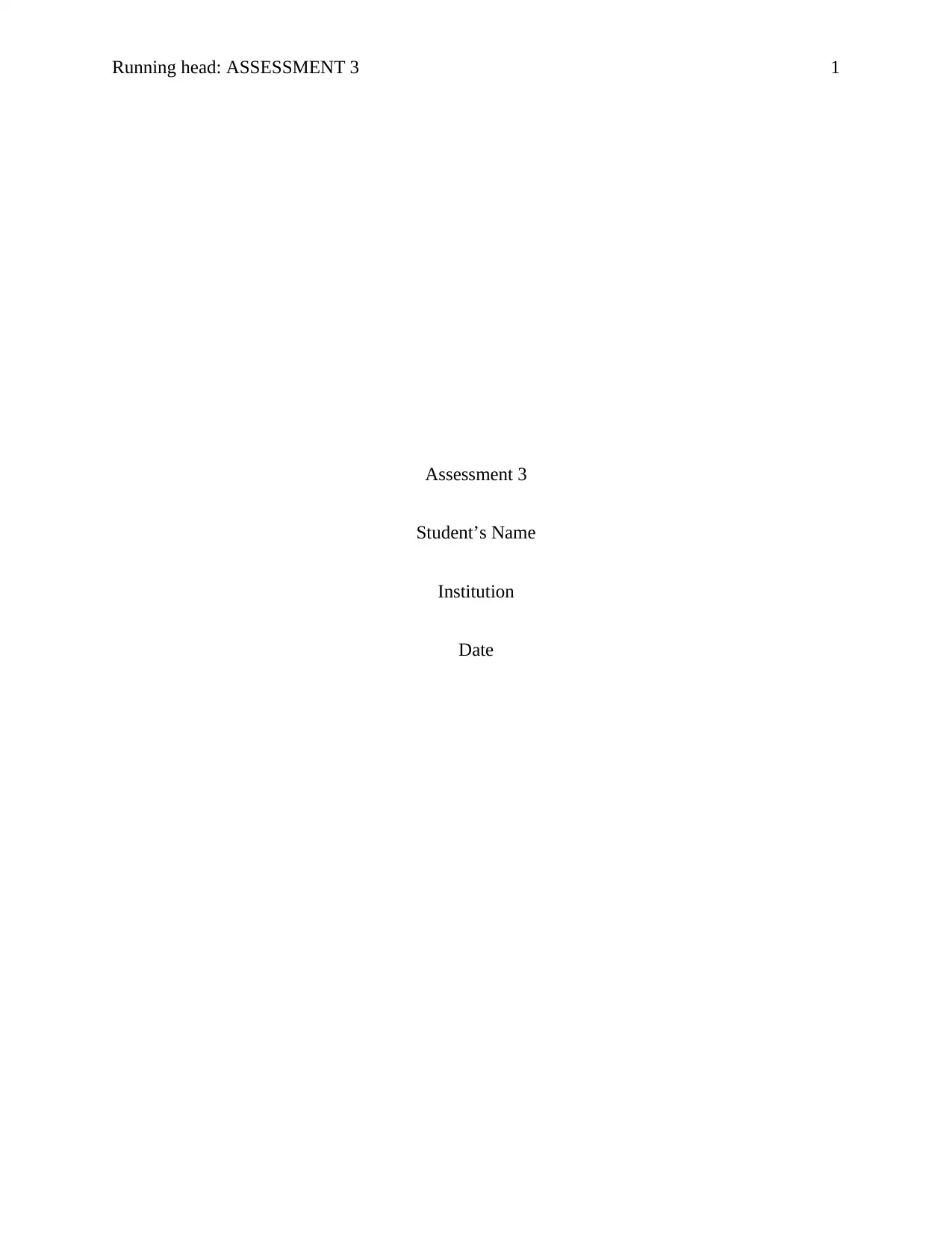
Running head: ASSESSMENT 3 1
Assessment 3
Student’s Name
Institution
Date
Assessment 3
Student’s Name
Institution
Date
Paraphrase This Document
Need a fresh take? Get an instant paraphrase of this document with our AI Paraphraser
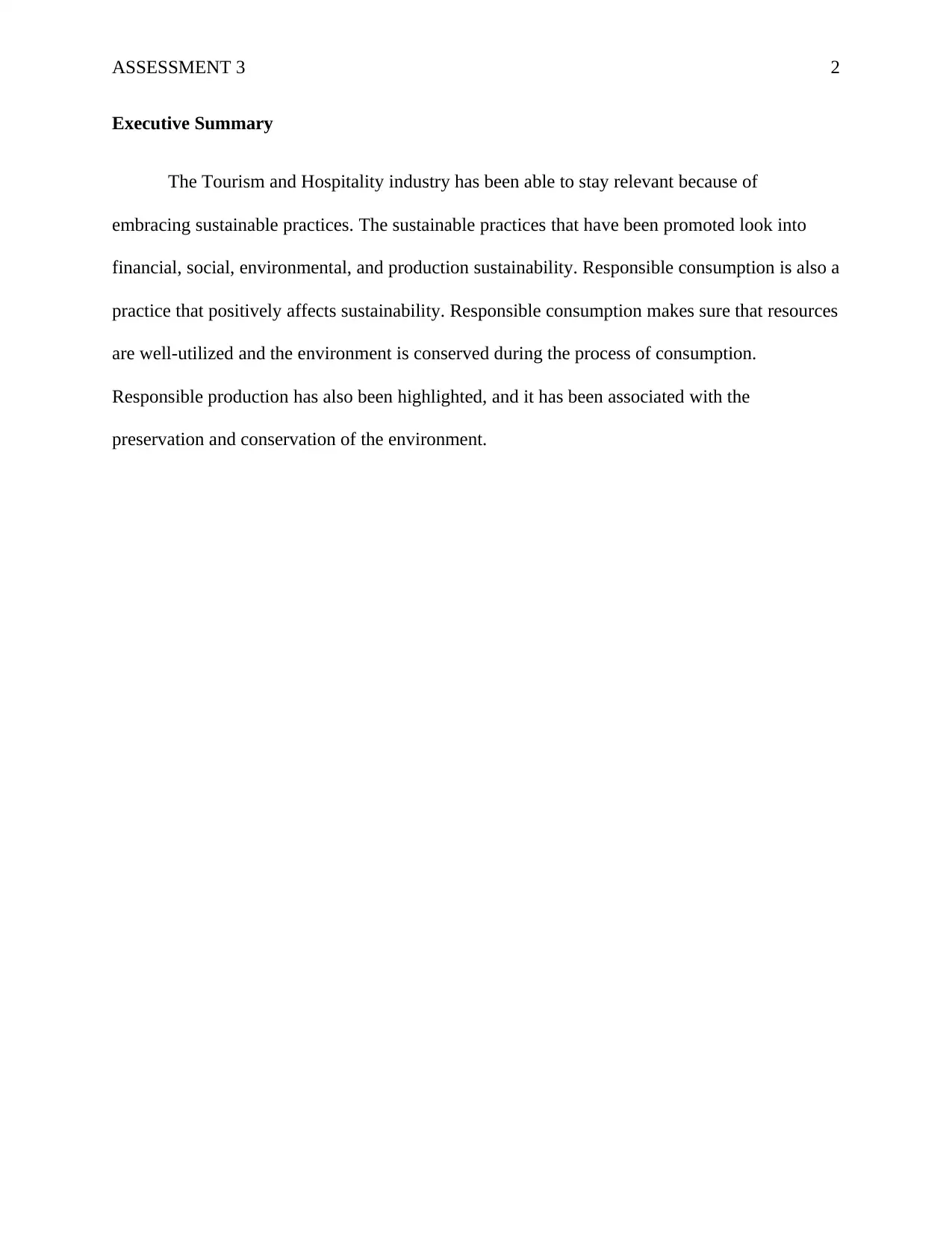
ASSESSMENT 3 2
Executive Summary
The Tourism and Hospitality industry has been able to stay relevant because of
embracing sustainable practices. The sustainable practices that have been promoted look into
financial, social, environmental, and production sustainability. Responsible consumption is also a
practice that positively affects sustainability. Responsible consumption makes sure that resources
are well-utilized and the environment is conserved during the process of consumption.
Responsible production has also been highlighted, and it has been associated with the
preservation and conservation of the environment.
Executive Summary
The Tourism and Hospitality industry has been able to stay relevant because of
embracing sustainable practices. The sustainable practices that have been promoted look into
financial, social, environmental, and production sustainability. Responsible consumption is also a
practice that positively affects sustainability. Responsible consumption makes sure that resources
are well-utilized and the environment is conserved during the process of consumption.
Responsible production has also been highlighted, and it has been associated with the
preservation and conservation of the environment.
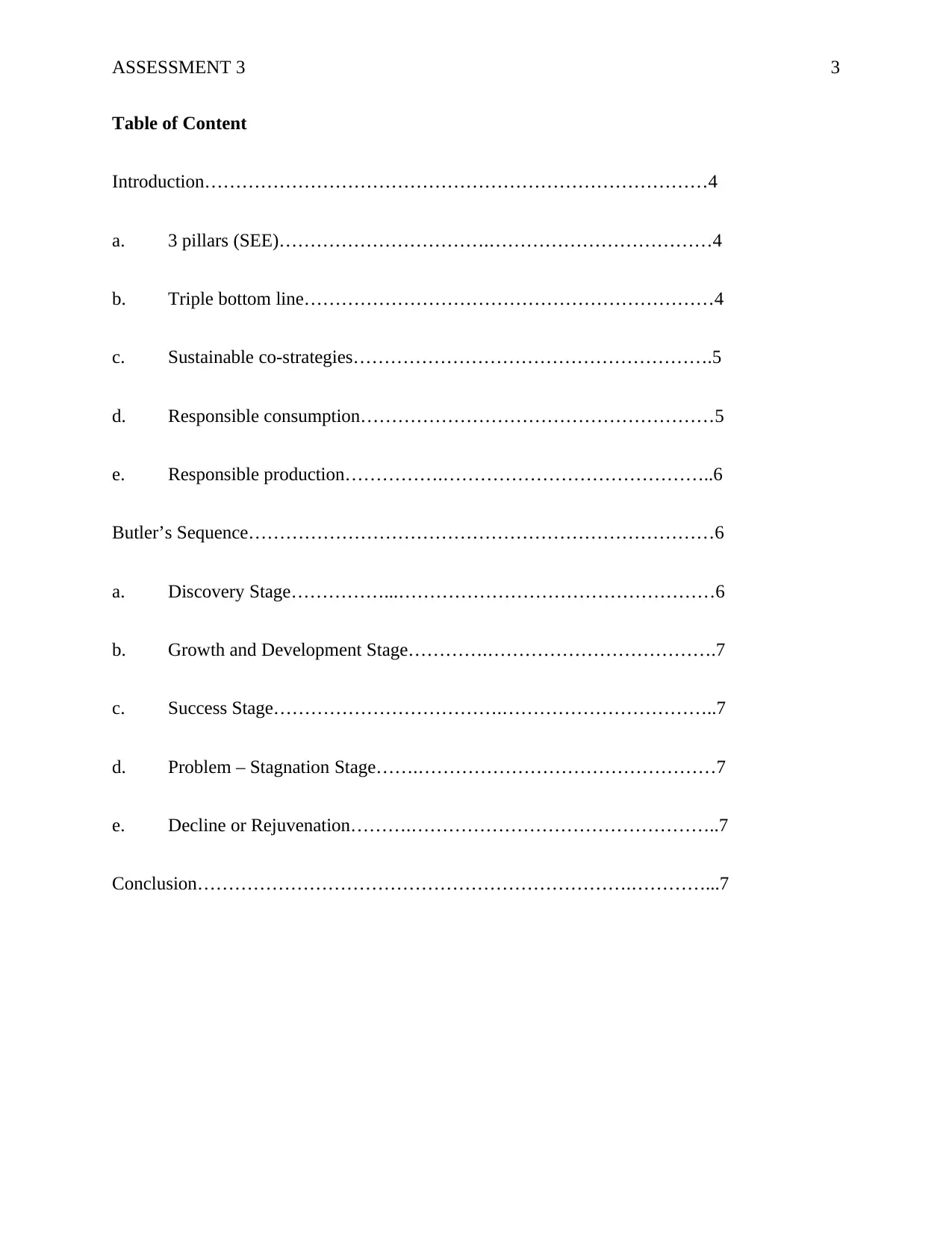
ASSESSMENT 3 3
Table of Content
Introduction………………………………………………………………………4
a. 3 pillars (SEE)…………………………….………………………………4
b. Triple bottom line…………………………………………………………4
c. Sustainable co-strategies………………………………………………….5
d. Responsible consumption…………………………………………………5
e. Responsible production…………….……………………………………..6
Butler’s Sequence…………………………………………………………………6
a. Discovery Stage……………...……………………………………………6
b. Growth and Development Stage………….……………………………….7
c. Success Stage……………………………….……………………………..7
d. Problem – Stagnation Stage…….…………………………………………7
e. Decline or Rejuvenation……….…………………………………………..7
Conclusion…………………………………………………………….…………...7
Table of Content
Introduction………………………………………………………………………4
a. 3 pillars (SEE)…………………………….………………………………4
b. Triple bottom line…………………………………………………………4
c. Sustainable co-strategies………………………………………………….5
d. Responsible consumption…………………………………………………5
e. Responsible production…………….……………………………………..6
Butler’s Sequence…………………………………………………………………6
a. Discovery Stage……………...……………………………………………6
b. Growth and Development Stage………….……………………………….7
c. Success Stage……………………………….……………………………..7
d. Problem – Stagnation Stage…….…………………………………………7
e. Decline or Rejuvenation……….…………………………………………..7
Conclusion…………………………………………………………….…………...7
⊘ This is a preview!⊘
Do you want full access?
Subscribe today to unlock all pages.

Trusted by 1+ million students worldwide
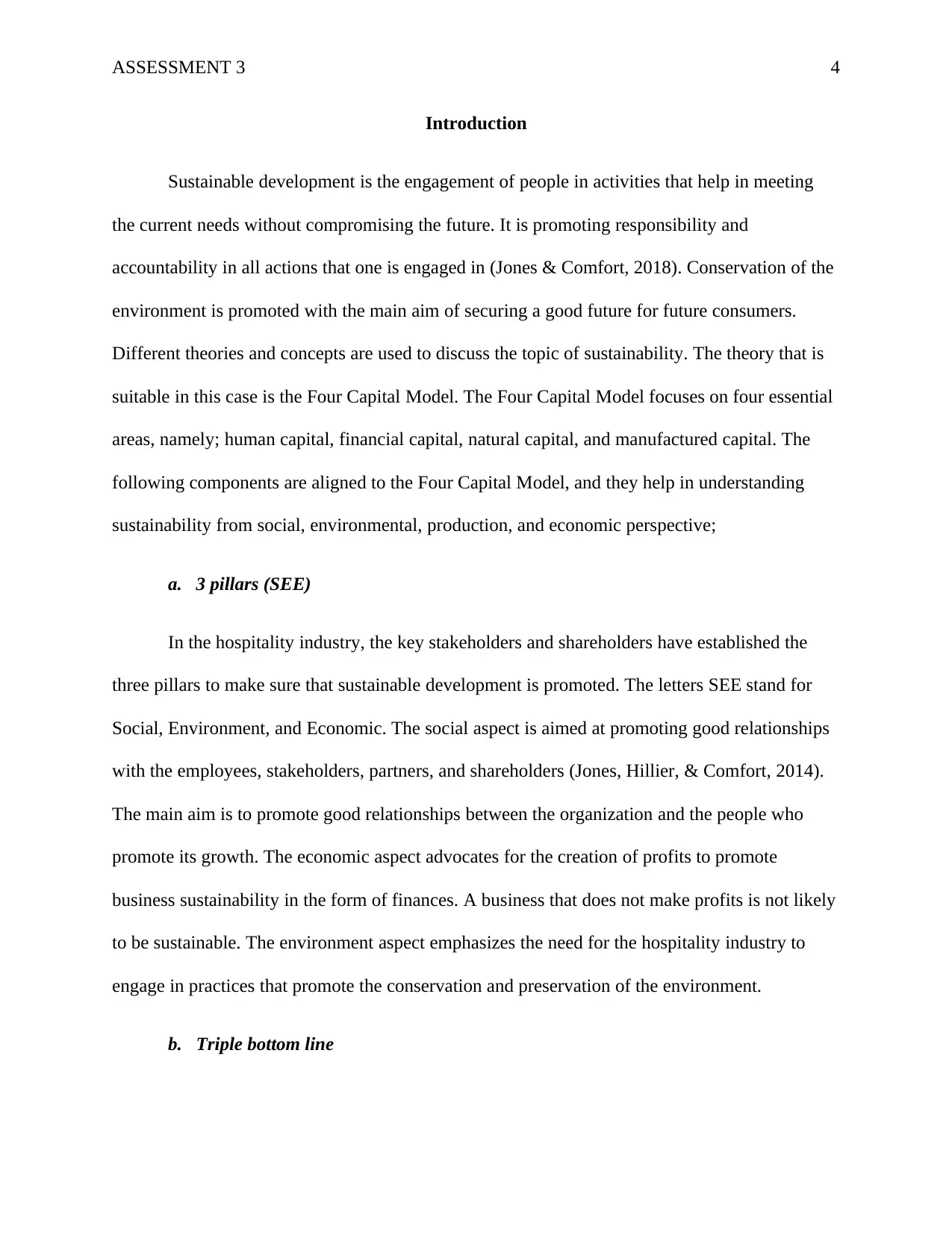
ASSESSMENT 3 4
Introduction
Sustainable development is the engagement of people in activities that help in meeting
the current needs without compromising the future. It is promoting responsibility and
accountability in all actions that one is engaged in (Jones & Comfort, 2018). Conservation of the
environment is promoted with the main aim of securing a good future for future consumers.
Different theories and concepts are used to discuss the topic of sustainability. The theory that is
suitable in this case is the Four Capital Model. The Four Capital Model focuses on four essential
areas, namely; human capital, financial capital, natural capital, and manufactured capital. The
following components are aligned to the Four Capital Model, and they help in understanding
sustainability from social, environmental, production, and economic perspective;
a. 3 pillars (SEE)
In the hospitality industry, the key stakeholders and shareholders have established the
three pillars to make sure that sustainable development is promoted. The letters SEE stand for
Social, Environment, and Economic. The social aspect is aimed at promoting good relationships
with the employees, stakeholders, partners, and shareholders (Jones, Hillier, & Comfort, 2014).
The main aim is to promote good relationships between the organization and the people who
promote its growth. The economic aspect advocates for the creation of profits to promote
business sustainability in the form of finances. A business that does not make profits is not likely
to be sustainable. The environment aspect emphasizes the need for the hospitality industry to
engage in practices that promote the conservation and preservation of the environment.
b. Triple bottom line
Introduction
Sustainable development is the engagement of people in activities that help in meeting
the current needs without compromising the future. It is promoting responsibility and
accountability in all actions that one is engaged in (Jones & Comfort, 2018). Conservation of the
environment is promoted with the main aim of securing a good future for future consumers.
Different theories and concepts are used to discuss the topic of sustainability. The theory that is
suitable in this case is the Four Capital Model. The Four Capital Model focuses on four essential
areas, namely; human capital, financial capital, natural capital, and manufactured capital. The
following components are aligned to the Four Capital Model, and they help in understanding
sustainability from social, environmental, production, and economic perspective;
a. 3 pillars (SEE)
In the hospitality industry, the key stakeholders and shareholders have established the
three pillars to make sure that sustainable development is promoted. The letters SEE stand for
Social, Environment, and Economic. The social aspect is aimed at promoting good relationships
with the employees, stakeholders, partners, and shareholders (Jones, Hillier, & Comfort, 2014).
The main aim is to promote good relationships between the organization and the people who
promote its growth. The economic aspect advocates for the creation of profits to promote
business sustainability in the form of finances. A business that does not make profits is not likely
to be sustainable. The environment aspect emphasizes the need for the hospitality industry to
engage in practices that promote the conservation and preservation of the environment.
b. Triple bottom line
Paraphrase This Document
Need a fresh take? Get an instant paraphrase of this document with our AI Paraphraser
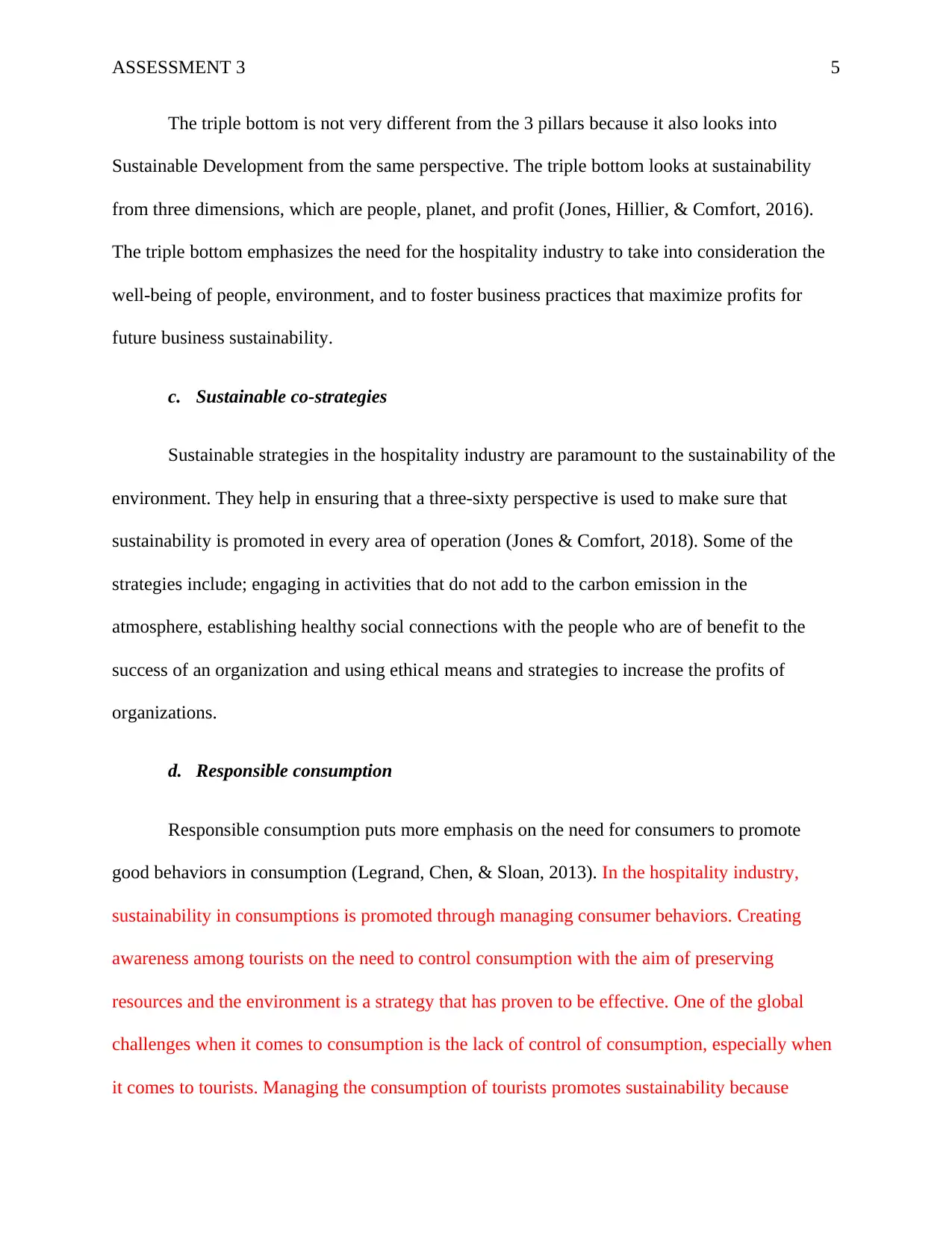
ASSESSMENT 3 5
The triple bottom is not very different from the 3 pillars because it also looks into
Sustainable Development from the same perspective. The triple bottom looks at sustainability
from three dimensions, which are people, planet, and profit (Jones, Hillier, & Comfort, 2016).
The triple bottom emphasizes the need for the hospitality industry to take into consideration the
well-being of people, environment, and to foster business practices that maximize profits for
future business sustainability.
c. Sustainable co-strategies
Sustainable strategies in the hospitality industry are paramount to the sustainability of the
environment. They help in ensuring that a three-sixty perspective is used to make sure that
sustainability is promoted in every area of operation (Jones & Comfort, 2018). Some of the
strategies include; engaging in activities that do not add to the carbon emission in the
atmosphere, establishing healthy social connections with the people who are of benefit to the
success of an organization and using ethical means and strategies to increase the profits of
organizations.
d. Responsible consumption
Responsible consumption puts more emphasis on the need for consumers to promote
good behaviors in consumption (Legrand, Chen, & Sloan, 2013). In the hospitality industry,
sustainability in consumptions is promoted through managing consumer behaviors. Creating
awareness among tourists on the need to control consumption with the aim of preserving
resources and the environment is a strategy that has proven to be effective. One of the global
challenges when it comes to consumption is the lack of control of consumption, especially when
it comes to tourists. Managing the consumption of tourists promotes sustainability because
The triple bottom is not very different from the 3 pillars because it also looks into
Sustainable Development from the same perspective. The triple bottom looks at sustainability
from three dimensions, which are people, planet, and profit (Jones, Hillier, & Comfort, 2016).
The triple bottom emphasizes the need for the hospitality industry to take into consideration the
well-being of people, environment, and to foster business practices that maximize profits for
future business sustainability.
c. Sustainable co-strategies
Sustainable strategies in the hospitality industry are paramount to the sustainability of the
environment. They help in ensuring that a three-sixty perspective is used to make sure that
sustainability is promoted in every area of operation (Jones & Comfort, 2018). Some of the
strategies include; engaging in activities that do not add to the carbon emission in the
atmosphere, establishing healthy social connections with the people who are of benefit to the
success of an organization and using ethical means and strategies to increase the profits of
organizations.
d. Responsible consumption
Responsible consumption puts more emphasis on the need for consumers to promote
good behaviors in consumption (Legrand, Chen, & Sloan, 2013). In the hospitality industry,
sustainability in consumptions is promoted through managing consumer behaviors. Creating
awareness among tourists on the need to control consumption with the aim of preserving
resources and the environment is a strategy that has proven to be effective. One of the global
challenges when it comes to consumption is the lack of control of consumption, especially when
it comes to tourists. Managing the consumption of tourists promotes sustainability because
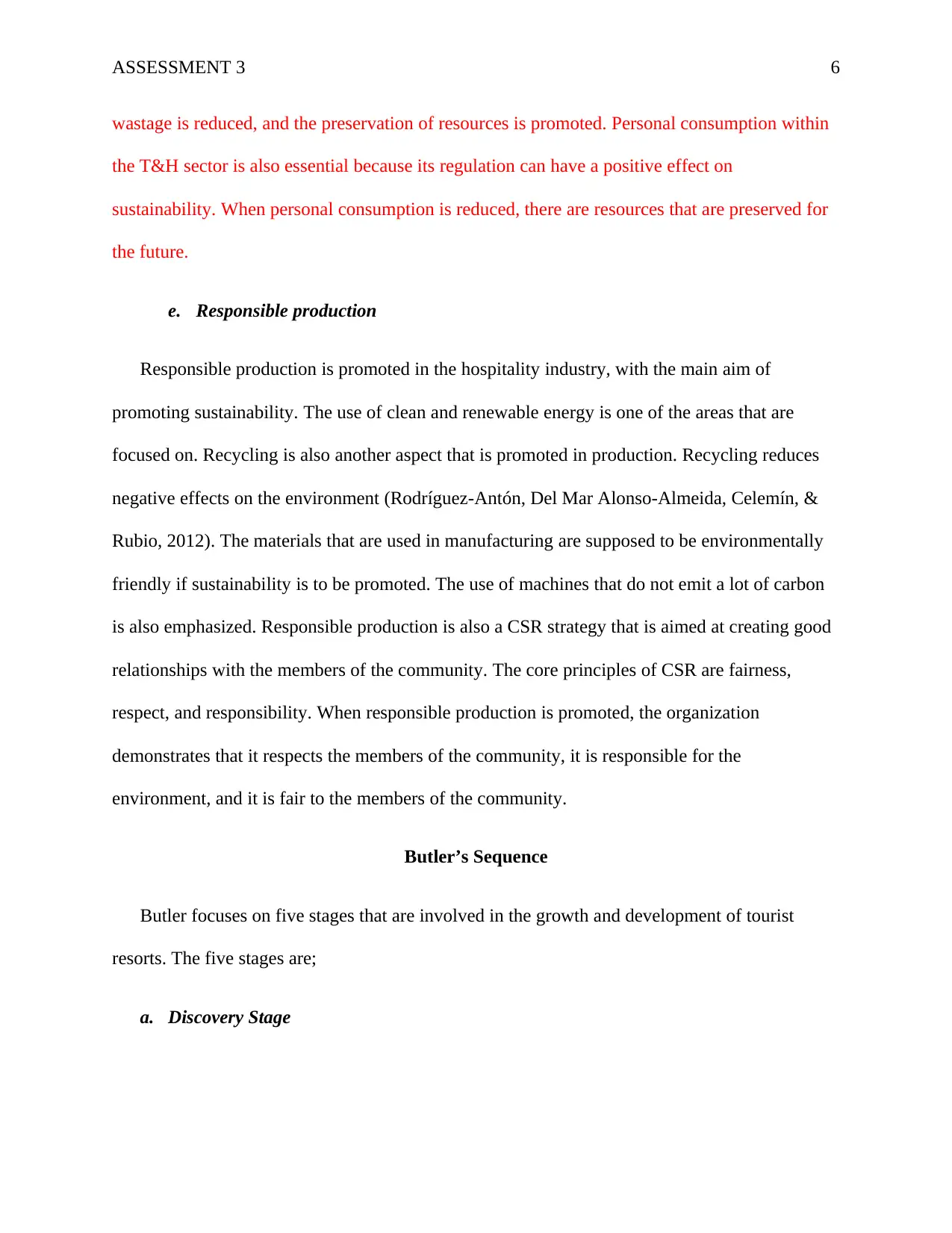
ASSESSMENT 3 6
wastage is reduced, and the preservation of resources is promoted. Personal consumption within
the T&H sector is also essential because its regulation can have a positive effect on
sustainability. When personal consumption is reduced, there are resources that are preserved for
the future.
e. Responsible production
Responsible production is promoted in the hospitality industry, with the main aim of
promoting sustainability. The use of clean and renewable energy is one of the areas that are
focused on. Recycling is also another aspect that is promoted in production. Recycling reduces
negative effects on the environment (Rodríguez-Antón, Del Mar Alonso-Almeida, Celemín, &
Rubio, 2012). The materials that are used in manufacturing are supposed to be environmentally
friendly if sustainability is to be promoted. The use of machines that do not emit a lot of carbon
is also emphasized. Responsible production is also a CSR strategy that is aimed at creating good
relationships with the members of the community. The core principles of CSR are fairness,
respect, and responsibility. When responsible production is promoted, the organization
demonstrates that it respects the members of the community, it is responsible for the
environment, and it is fair to the members of the community.
Butler’s Sequence
Butler focuses on five stages that are involved in the growth and development of tourist
resorts. The five stages are;
a. Discovery Stage
wastage is reduced, and the preservation of resources is promoted. Personal consumption within
the T&H sector is also essential because its regulation can have a positive effect on
sustainability. When personal consumption is reduced, there are resources that are preserved for
the future.
e. Responsible production
Responsible production is promoted in the hospitality industry, with the main aim of
promoting sustainability. The use of clean and renewable energy is one of the areas that are
focused on. Recycling is also another aspect that is promoted in production. Recycling reduces
negative effects on the environment (Rodríguez-Antón, Del Mar Alonso-Almeida, Celemín, &
Rubio, 2012). The materials that are used in manufacturing are supposed to be environmentally
friendly if sustainability is to be promoted. The use of machines that do not emit a lot of carbon
is also emphasized. Responsible production is also a CSR strategy that is aimed at creating good
relationships with the members of the community. The core principles of CSR are fairness,
respect, and responsibility. When responsible production is promoted, the organization
demonstrates that it respects the members of the community, it is responsible for the
environment, and it is fair to the members of the community.
Butler’s Sequence
Butler focuses on five stages that are involved in the growth and development of tourist
resorts. The five stages are;
a. Discovery Stage
⊘ This is a preview!⊘
Do you want full access?
Subscribe today to unlock all pages.

Trusted by 1+ million students worldwide
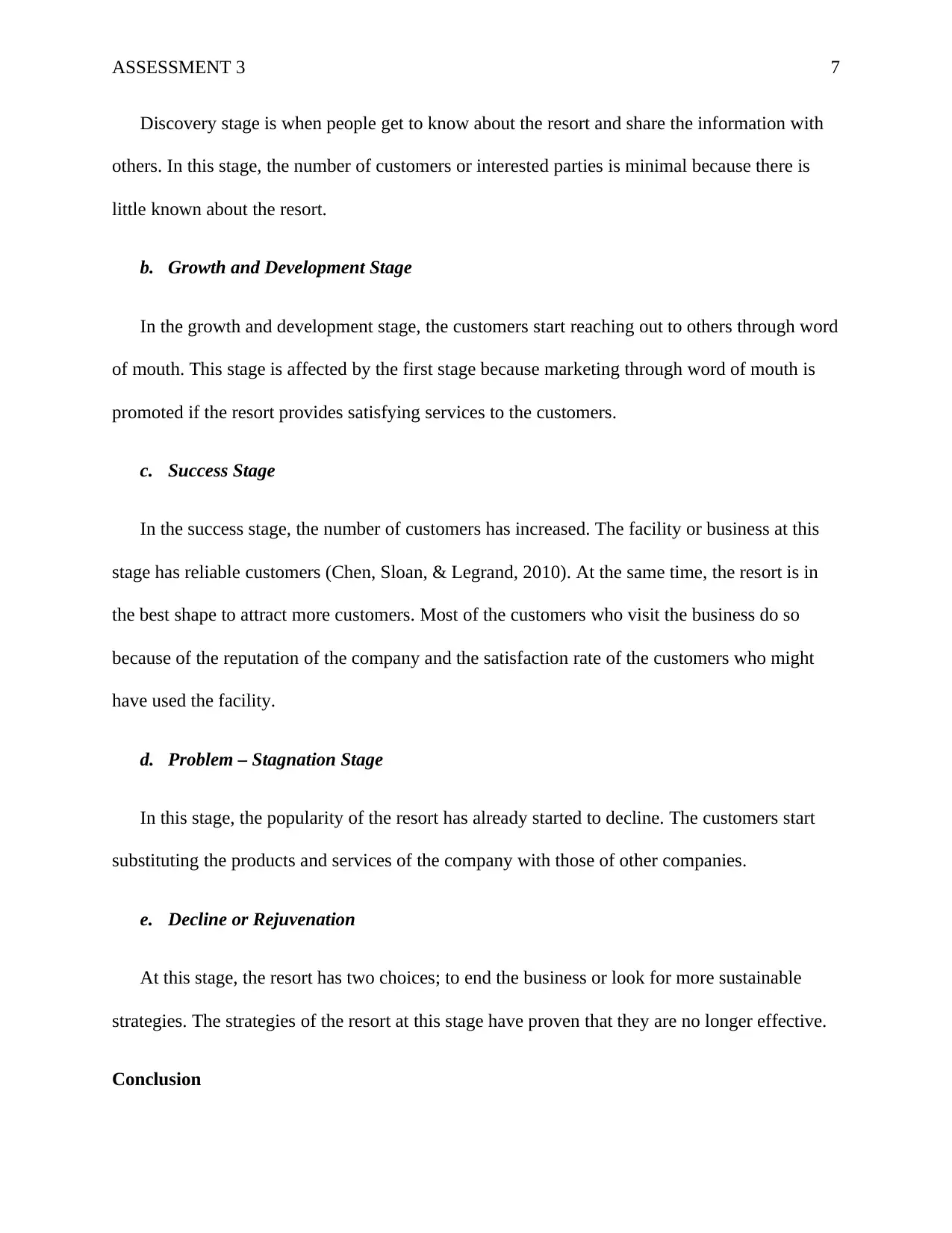
ASSESSMENT 3 7
Discovery stage is when people get to know about the resort and share the information with
others. In this stage, the number of customers or interested parties is minimal because there is
little known about the resort.
b. Growth and Development Stage
In the growth and development stage, the customers start reaching out to others through word
of mouth. This stage is affected by the first stage because marketing through word of mouth is
promoted if the resort provides satisfying services to the customers.
c. Success Stage
In the success stage, the number of customers has increased. The facility or business at this
stage has reliable customers (Chen, Sloan, & Legrand, 2010). At the same time, the resort is in
the best shape to attract more customers. Most of the customers who visit the business do so
because of the reputation of the company and the satisfaction rate of the customers who might
have used the facility.
d. Problem – Stagnation Stage
In this stage, the popularity of the resort has already started to decline. The customers start
substituting the products and services of the company with those of other companies.
e. Decline or Rejuvenation
At this stage, the resort has two choices; to end the business or look for more sustainable
strategies. The strategies of the resort at this stage have proven that they are no longer effective.
Conclusion
Discovery stage is when people get to know about the resort and share the information with
others. In this stage, the number of customers or interested parties is minimal because there is
little known about the resort.
b. Growth and Development Stage
In the growth and development stage, the customers start reaching out to others through word
of mouth. This stage is affected by the first stage because marketing through word of mouth is
promoted if the resort provides satisfying services to the customers.
c. Success Stage
In the success stage, the number of customers has increased. The facility or business at this
stage has reliable customers (Chen, Sloan, & Legrand, 2010). At the same time, the resort is in
the best shape to attract more customers. Most of the customers who visit the business do so
because of the reputation of the company and the satisfaction rate of the customers who might
have used the facility.
d. Problem – Stagnation Stage
In this stage, the popularity of the resort has already started to decline. The customers start
substituting the products and services of the company with those of other companies.
e. Decline or Rejuvenation
At this stage, the resort has two choices; to end the business or look for more sustainable
strategies. The strategies of the resort at this stage have proven that they are no longer effective.
Conclusion
Paraphrase This Document
Need a fresh take? Get an instant paraphrase of this document with our AI Paraphraser
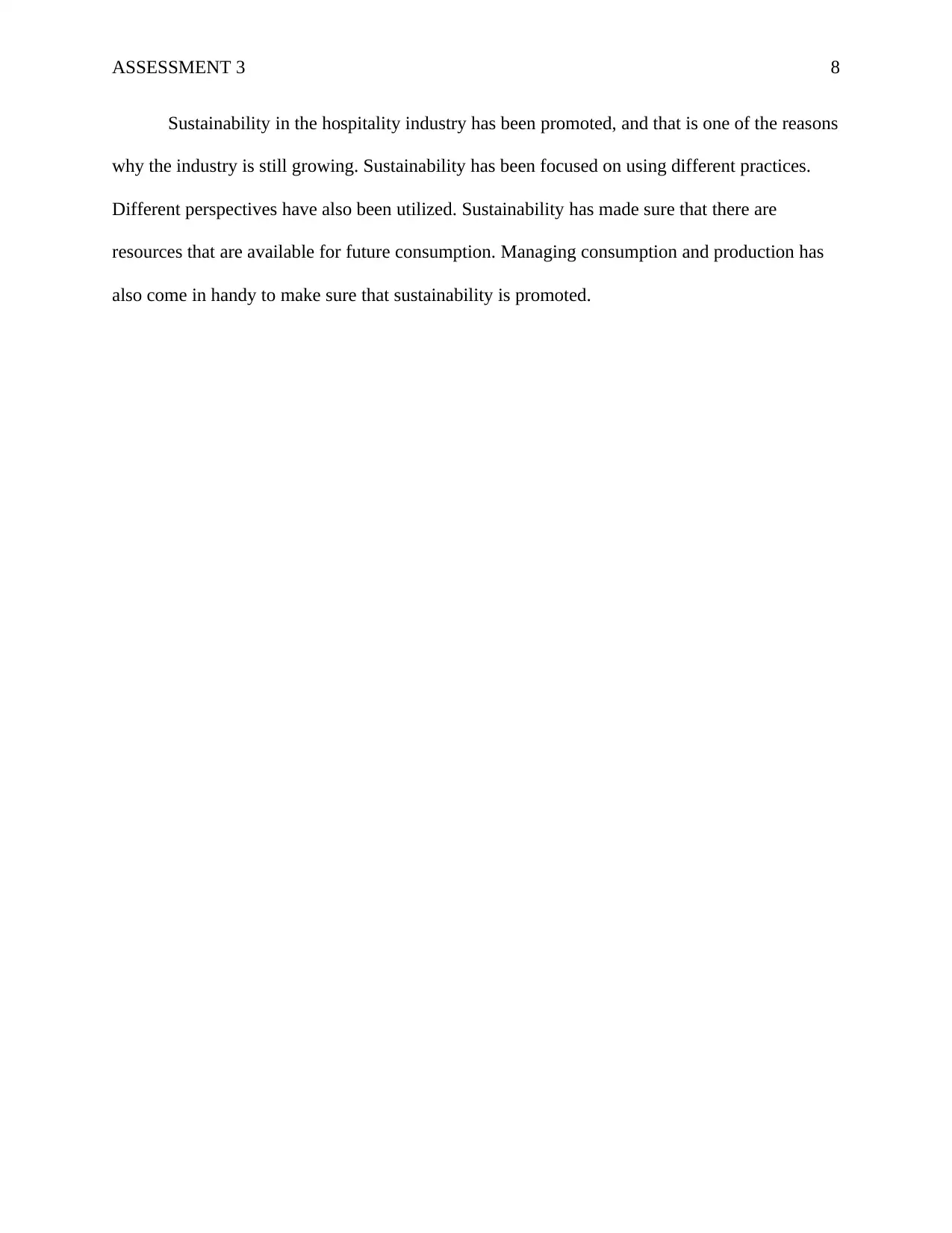
ASSESSMENT 3 8
Sustainability in the hospitality industry has been promoted, and that is one of the reasons
why the industry is still growing. Sustainability has been focused on using different practices.
Different perspectives have also been utilized. Sustainability has made sure that there are
resources that are available for future consumption. Managing consumption and production has
also come in handy to make sure that sustainability is promoted.
Sustainability in the hospitality industry has been promoted, and that is one of the reasons
why the industry is still growing. Sustainability has been focused on using different practices.
Different perspectives have also been utilized. Sustainability has made sure that there are
resources that are available for future consumption. Managing consumption and production has
also come in handy to make sure that sustainability is promoted.
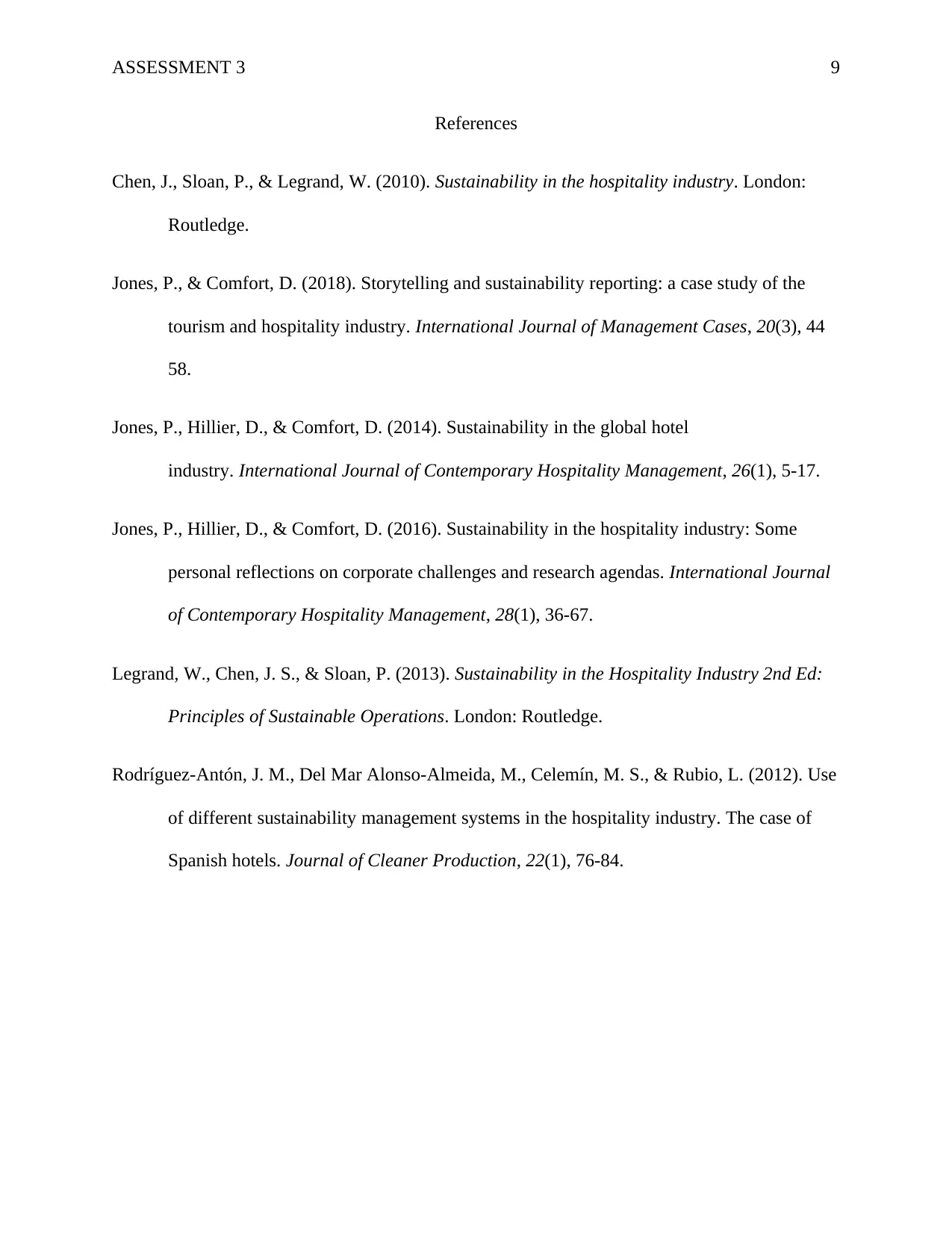
ASSESSMENT 3 9
References
Chen, J., Sloan, P., & Legrand, W. (2010). Sustainability in the hospitality industry. London:
Routledge.
Jones, P., & Comfort, D. (2018). Storytelling and sustainability reporting: a case study of the
tourism and hospitality industry. International Journal of Management Cases, 20(3), 44
58.
Jones, P., Hillier, D., & Comfort, D. (2014). Sustainability in the global hotel
industry. International Journal of Contemporary Hospitality Management, 26(1), 5-17.
Jones, P., Hillier, D., & Comfort, D. (2016). Sustainability in the hospitality industry: Some
personal reflections on corporate challenges and research agendas. International Journal
of Contemporary Hospitality Management, 28(1), 36-67.
Legrand, W., Chen, J. S., & Sloan, P. (2013). Sustainability in the Hospitality Industry 2nd Ed:
Principles of Sustainable Operations. London: Routledge.
Rodríguez-Antón, J. M., Del Mar Alonso-Almeida, M., Celemín, M. S., & Rubio, L. (2012). Use
of different sustainability management systems in the hospitality industry. The case of
Spanish hotels. Journal of Cleaner Production, 22(1), 76-84.
References
Chen, J., Sloan, P., & Legrand, W. (2010). Sustainability in the hospitality industry. London:
Routledge.
Jones, P., & Comfort, D. (2018). Storytelling and sustainability reporting: a case study of the
tourism and hospitality industry. International Journal of Management Cases, 20(3), 44
58.
Jones, P., Hillier, D., & Comfort, D. (2014). Sustainability in the global hotel
industry. International Journal of Contemporary Hospitality Management, 26(1), 5-17.
Jones, P., Hillier, D., & Comfort, D. (2016). Sustainability in the hospitality industry: Some
personal reflections on corporate challenges and research agendas. International Journal
of Contemporary Hospitality Management, 28(1), 36-67.
Legrand, W., Chen, J. S., & Sloan, P. (2013). Sustainability in the Hospitality Industry 2nd Ed:
Principles of Sustainable Operations. London: Routledge.
Rodríguez-Antón, J. M., Del Mar Alonso-Almeida, M., Celemín, M. S., & Rubio, L. (2012). Use
of different sustainability management systems in the hospitality industry. The case of
Spanish hotels. Journal of Cleaner Production, 22(1), 76-84.
⊘ This is a preview!⊘
Do you want full access?
Subscribe today to unlock all pages.

Trusted by 1+ million students worldwide
1 out of 9
Related Documents
Your All-in-One AI-Powered Toolkit for Academic Success.
+13062052269
info@desklib.com
Available 24*7 on WhatsApp / Email
![[object Object]](/_next/static/media/star-bottom.7253800d.svg)
Unlock your academic potential
Copyright © 2020–2025 A2Z Services. All Rights Reserved. Developed and managed by ZUCOL.




